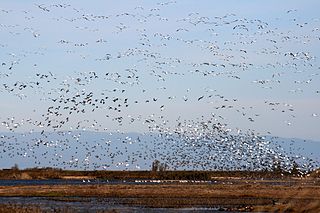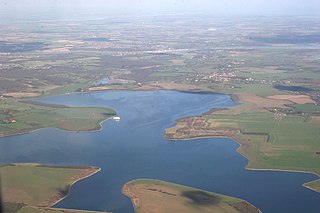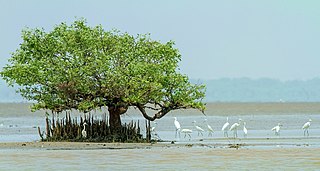
The grey heron is a long-legged wading bird of the heron family, Ardeidae, native throughout temperate Europe and Asia and also parts of Africa. It is resident in much of its range, but some populations from the more northern parts migrate southwards in autumn. A bird of wetland areas, it can be seen around lakes, rivers, ponds, marshes and on the sea coast. It feeds mostly on aquatic creatures which it catches after standing stationary beside or in the water or stalking its prey through the shallows.

The Sacramento National Wildlife Refuge Complex is part of the United States system of National Wildlife Refuges (NWR). It is located in northern California, in the valley of the Sacramento River.

Abberton Reservoir is a pumped storage freshwater reservoir in eastern England near the Essex coast, with an area of 700 hectares. Most of its water is pumped from the River Stour. It is the largest body of freshwater in Essex.

Lake Argyle is Western Australia's largest and Australia's second largest freshwater man-made reservoir by volume. The reservoir is part of the Ord River Irrigation Scheme and is located near the East Kimberley town of Kununurra. The lake flooded large parts of the Shire of Wyndham-East Kimberley on the Kimberley Plateau about 80 kilometres (50 mi) inland from the Joseph Bonaparte Gulf, close to the border with the Northern Territory.

Periyar, IPA: [peɾijɐːr], is the longest river and the river with the largest discharge potential in the Indian state of Kerala. It is one of the few perennial rivers in the region and provides drinking water for several major towns. The Periyar is of utmost significance to the economy of Kerala. It generates a significant proportion of Kerala's electrical power via the Idukki Dam and flows along a region of industrial and commercial activity. The river also provides water for irrigation and domestic use throughout its course besides supporting a rich fishery. Due to these reasons, the river has been named the "Lifeline of Kerala". Kochi city, in the vicinity of the river mouth draws its water supply from Aluva, an upstream site sufficiently free of seawater intrusion. Twenty five percent of Kerala's industries are along the banks of river Periyar. These are mostly crowded within a stretch of 5 kilometres (3 mi) in the Eloor-Edayar region (Udhyogamandal), about 10 kilometres (6 mi) north of Kochi harbor.

The Brent Reservoir is a reservoir in North West London. It straddles the boundary between the boroughs of Brent and Barnet and is owned by the Canal & River Trust. The reservoir takes its informal name from a public house called The Welsh Harp, which stood nearby until the early 1970s. It is a 68.6-hectare (170-acre) biological Site of Special Scientific Interest (SSSI), the only SSSI in either borough and among more than 30 SSSIs in Greater London.

Ranganathittu Bird Sanctuary, is a bird sanctuary in the Mandya District of the state of Karnataka in India. It is the largest bird sanctuary in the state, 40 acres (16 ha) in area, and comprises six islets on the banks of the Kaveri river.

Coringa Wildlife Sanctuary is a wildlife sanctuary and estuary situated near Kakinada in Andhra Pradesh, India. It is the third largest stretch of mangrove forests in India with 24 mangrove tree species and more than 120 bird species. It is home to the critically endangered white-backed vulture and the long billed vulture. In a mangrove ecosystem the water bodies of the ocean/sea and the river meet at a certain point.

Keenjhar Lake commonly called Malik Lake is located in Thatta District of Sindh the province of Pakistan. It is situated about 36 kilometres (22 mi) from the city of Thatta. It is the largest fresh water lake in Pakistan and an important source of drinking water for Thatta District and Karachi city. Through the construction of a bund on the eastern side, it is said that the lake was formed by the union of two lakes: Sonehri and Keenjhar.

Maharana Pratap Sagar, also known as Pong Reservoir or Pong Dam Lake is a large reservoir in Fatehpur, Jawali and Dehra tehsil of Kangra district of the state of Himachal Pradesh in India. It was created in 1975, by building the highest earthfill dam in India on the Beas River in the wetland zone of the Siwalik Hills. Named in the honour of Maharana Pratap (1540–1597), the reservoir or the lake is a well-known wildlife sanctuary and one of the 27 international wetland sites declared in India by the Ramsar Convention. The reservoir covers an area of 24,529 hectares, and the wetlands portion is 15,662 hectares.

Manjira wildlife sanctuary is a wildlife sanctuary and reservoir located in the Sangareddy district of Telangana State, India. Originally a crocodile sanctuary developed to protect the vulnerable species mugger crocodile, today it is home to more than 70 species of birds. The reservoir, located in the sanctuary, provides drinking water to Hyderabad and Secundarabad.

Jayakwadi dam is an earthen dam located on Godavari river at the site of Jayakwadi village in Paithan taluka of Aurangabad district in Maharashtra, India. It is a multipurpose project. The water is mainly used to irrigate agricultural land in the drought-prone Marathwada region of the state. It also provides water for drinking and industrial usage to nearby towns and villages and to the municipalities and industrial areas of Aurangabad and Jalna districts. The surrounding area of the dam has a garden and a bird sanctuary.
Chitrangudi Bird Sanctuary locally known as "Chitrangudi Kanmoli" is a .4763 km2 (0.1839 sq mi) Protected area declared in 1989 and a part of Chitrangudi village, Mudukulathur Taluk, Ramanathapuram District, Tamil Nadu, India. It is adjacent to Kanjirankulam Bird Sanctuary. It is notable as a nesting site for several migratory heron species that roost in the prominent growth of Babul trees there. International name: Chitragudi and Kanjirankulam Bird Sanctuary, IBA Code: IN261, Criteria: A1, A4i.
Kokkilai lagoon is an estuarine lagoon in Mullaitivu District and Trincomalee District, north-east Sri Lanka. The town of Kokkilai is located on a sand bar between the lagoon and the Indian Ocean.

Chandaka Elephant Sanctuary is a wildlife reserve located in the south fringe of cuttack in the Indian state of Odisha. Nestled on Khurdha uplands of the Eastern Ghats biotic region, Chandaka forest is spread over 175.79 square kilometres (67.87 sq mi) of rolling table land and small sprawling hillocks of Khurdha and Cuttack Districts. It was designated as an elephant reserve in December 1982.

Housing more than 200 resident and wintering bird species, Chennai has long been a haven for bird watchers. It is the one of the few urban areas in India with diverse range of birds including greater flamingo, black baza, osprey, Indian eagle-owl, Coppersmith barbet, Spot billed pelican and pied avocet can be seen. The following are some known birding hotspots in and around Chennai.
The Lotsane Dam is a dam on the Lotsane River in Botswana completed in 2012. Its purpose is to provide drinking water to local villagers and to support a horticultural project.

Kayrakkum Reservoir, also spelled variously as Qayroqqum,Qayraqqum,Kayrakum or Kairakum, is a large artificial lake in Ghafurov District of Sughd Province, in northwestern Tajikistan. In 2016, the reservoir was renamed Tajik Sea by the country's parliament. The reservoir lies in the western part of the Fergana Valley on the Syr Darya river. The provincial capital of Khujand lies about 15 km west of the dam. It is also a Ramsar site.

Nalbana Bird Sanctuary or Nalbana Island is the core area of the Ramsar designated wetlands of Chilika Lake. It was declared a bird sanctuary under the Wildlife Protection Act in 1972. In the heart of the park, one can see thousands of birds descending during the migratory season. The island disappears during monsoon season due to inundation only to emerge again in post-monsoon.

Nagi Bird Sanctuary is located in Jhajha Jamui district of south Bihar, near the Jharkhand border. It was declared a bird sanctuary on 25 February 1984 as per Section 18 of the Wildlife (Protection) Act, 1972. The final notification under Section 26A of the act was issued on 4 September 2009. Thousands of migrating birds congregate in the reservoir during the winter season, especially from November to February. The area of the sanctuary is 2.1 square kilometres. It is home to over 133 bird species. There are also a variety of dragonflies, damselflies and butterflies which are yet to be studied and documented. In 2004, Nagi Dam Bird Sanctuary was declared an Important Bird Area (IBA) by BirdLife International. The area overlapping with the IBA is 791 ha.

















